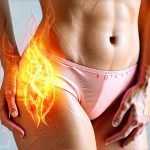Bladder pain is a debilitating condition affecting millions worldwide, often described as anything from a persistent ache to intense, burning discomfort in the pelvic region. It can significantly impact quality of life, interfering with sleep, work, and social activities. While many associate bladder pain with urinary tract infections or other readily identifiable causes, a substantial number of individuals experience chronic bladder pain without a clear diagnosis—leading to frustration and difficulty finding effective management strategies. This is where intriguing questions arise about the potential for cyclical patterns in bladder pain, mirroring hormonal fluctuations experienced during the menstrual cycle.
The idea that bladder pain might wax and wane similarly to premenstrual syndrome isn’t new, but it’s often overlooked or dismissed. Many women report experiencing a noticeable worsening of their bladder symptoms leading up to menstruation, suggesting a potential link between hormonal shifts and bladder function. Understanding this connection is crucial not only for accurate diagnosis but also for developing tailored treatment plans that address the cyclical nature of the pain. It’s important to emphasize that correlation does not equal causation, however; just because symptoms appear around the same time doesn’t necessarily mean one directly causes the other. Exploring the potential mechanisms and nuances behind this phenomenon is key to providing better support and care for individuals experiencing chronic bladder pain.
The Interplay of Hormones & Bladder Function
Hormonal fluctuations are a natural part of the menstrual cycle, impacting numerous bodily systems. Estrogen and progesterone, the primary hormones involved, play complex roles in regulating various functions, including mood, fluid balance, and even inflammation. It’s within these regulatory mechanisms that potential connections to bladder pain emerge. Estrogen, for example, influences the urothelium – the lining of the bladder – and can affect its permeability and sensitivity. Lower estrogen levels, particularly during menstruation, might lead to changes in the bladder wall, potentially increasing discomfort or urgency.
Progesterone also has implications. While it generally has a calming effect on smooth muscle (which includes the muscles of the bladder), fluctuations in progesterone levels can contribute to fluid retention and bloating, indirectly affecting bladder pressure and sensation. Furthermore, hormonal shifts can impact the nervous system’s pain processing centers, potentially lowering the threshold for perceived pain. This means that even normal bladder signals might be interpreted as painful during certain phases of the cycle. It’s also important to note that hormonal imbalances beyond the typical menstrual cycle—such as those experienced during perimenopause or menopause—can similarly contribute to altered bladder function and increased discomfort.
The complexity is further compounded by individual variations in hormonal sensitivity and pain perception. What one woman experiences as a minor annoyance might be significantly debilitating for another, depending on their unique physiological makeup and pre-existing conditions. This variability underscores the importance of individualized assessment and treatment approaches. Researchers are still working to fully understand the precise mechanisms linking hormones and bladder function, but growing evidence suggests a strong connection worth exploring in patients experiencing cyclical bladder pain.
Exploring Interstitial Cystitis/Bladder Pain Syndrome (IC/BPS)
Interstitial Cystitis/Bladder Pain Syndrome (IC/BPS) is a chronic condition characterized by persistent bladder pain or discomfort, often accompanied by urinary frequency and urgency. While the exact cause of IC/BPS remains unknown, many theories point to a combination of factors including nerve damage, immune system dysfunction, and potential bladder problems predispositions. Importantly, hormonal influences are increasingly recognized as playing a role in symptom presentation.
- Studies have shown that women with IC/BPS often report symptom flares coinciding with their menstrual cycles.
- Some research suggests estrogen deficiency may exacerbate bladder pain by compromising the protective barrier of the urothelium, making it more vulnerable to irritants and inflammation.
- Conversely, other studies explore the role of fluctuating hormone levels in modulating mast cell activity—immune cells involved in inflammatory responses within the bladder.
It’s crucial to distinguish between IC/BPS and simple urinary tract infections (UTIs), as the treatments differ significantly. UTIs are typically caused by bacterial infection and resolved with antibiotics, while IC/BPS requires a more holistic approach focusing on symptom management and reducing bladder irritation. Accurate diagnosis is essential for effective treatment. A comprehensive evaluation usually involves a detailed medical history, physical examination, urine tests to rule out infection, and potentially cystoscopy (a procedure to visualize the bladder lining).
The Role of Inflammation & Pelvic Floor Dysfunction
Chronic inflammation is implicated in many chronic pain conditions, including IC/BPS. Hormonal fluctuations can influence inflammatory processes within the body. For example, estrogen has been shown to modulate immune cell activity and cytokine production—molecules that play a key role in inflammation. Shifts in hormone levels could potentially trigger or exacerbate inflammatory responses in the bladder, leading to increased pain and discomfort. Furthermore, inflammation isn’t confined to the bladder itself; it can extend to surrounding pelvic structures, contributing to overall pelvic pain and dysfunction.
Pelvic floor dysfunction (PFD) is another common contributor to chronic bladder pain. The pelvic floor muscles support the bladder, uterus, and rectum. If these muscles become tight or weak, they can put pressure on the bladder and urethra, leading to urinary symptoms and pain. Hormonal changes can affect muscle tone and sensitivity, potentially contributing to PFD.
- Stress and anxiety, often heightened during PMS, can further exacerbate pelvic floor tension.
- Poor posture and habitual straining also contribute to PFD.
- Physical therapy specializing in pelvic floor rehabilitation is often a crucial component of IC/BPS management, aiming to restore muscle balance and reduce pain.
Navigating Diagnosis & Management Strategies
Diagnosing cyclical bladder pain requires a careful and comprehensive approach. A detailed patient history focusing on symptom timing relative to the menstrual cycle is paramount. Keeping a symptom diary can be incredibly helpful in identifying patterns and correlations. This diary should include information about:
- Pain intensity (using a scale of 1-10)
- Specific symptoms (urgency, frequency, burning sensation)
- Timing of symptoms in relation to the menstrual cycle
- Any potential triggers or alleviating factors
Physicians may also order tests to rule out other causes of bladder pain, such as UTIs, kidney stones, and sexually transmitted infections. Cystoscopy and urodynamic testing (evaluating bladder function) might be considered depending on individual circumstances.
Management strategies for cyclical bladder pain are often multifaceted and tailored to the individual. Options may include:
- Lifestyle Modifications: Avoiding bladder irritants (caffeine, alcohol, spicy foods), managing stress, and maintaining a healthy diet.
- Pelvic Floor Physical Therapy: Strengthening and relaxing pelvic floor muscles.
- Hormonal Therapies: In some cases, low-dose estrogen therapy or hormonal birth control might be considered under the guidance of a healthcare professional—but this is not a one-size-fits-all solution and requires careful evaluation.
- Pain Management Techniques: Including over-the-counter pain relievers, prescription medications (depending on severity), and complementary therapies such as acupuncture or mindfulness meditation.
Ultimately, recognizing the potential for cyclical patterns in bladder pain is crucial for providing empathetic, effective care. It empowers patients to advocate for their needs and encourages healthcare providers to consider a more nuanced understanding of this complex condition. Can bladder pain be misdiagnosed in women?





















